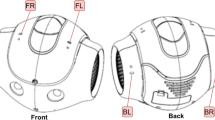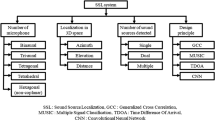Abstract
Sound Localization is the process of identifying direction (with distance) and location of the source from which the sound is detected. It is one of the important functions of human brain. In brain sound localization is done through the neurons present in it. The sound signals from the outside world are come inside the brain through the ear. In this paper, the process of Sound Localization activity performed by human brain that incorporates realistic neuron models is discussed and the accurate position of the sound sources by using the Kalman filter and neural network is examined. The results demonstrate that finding position in 3D is more accurate as compared in 2D as its average error gets reduced. This work can be used to detect the location of the sound sources in three dimensions and can be also implemented in robots and cochlear implants for treating hearing loss.
Similar content being viewed by others
References
Hongyangchen et. al. “Accurate and efficient node localization in wireless sensor networks”, February 2011.
Hon T., Wang L., Reiss J., Cavallaro A., “Audio Fingerprinting for Multi-Device Self-Localization” IEEE/ACM Transactions on Audio, Speech, and language processing, vol. 23, No. 10, October 2015.
Voutsas k., Langer G., Adamy J. and Ochse M, “A Brain-Like Neural Network for Periodicity Analysis” IEEE Transactions on Systems, Man, and Cybernetics, Vol. 35, No. 1, Feb 2005.
Voutsas K. and Adamy J., “A Biologically Inspired Spiking Neural Network for Sound Source Lateralization”, IEEE transactions on Neural Networks, Vol. 18, No. 6, November 2007.
Liu J., Gonzalez D., Rees A., Erwin H., Wermter S., “A biologically inspired spiking neural network model of the auditory midbrain for sound source localization”, Elsevier transaction on Neurocomputing 74(2010) 19–139.
Schaik A. V., Jin C., Carlile S., “Human Localisation of Band-pass Filtered Noise”, International Journal of Neural Systems, Vol. 9. No. 5 (October, 1999) 441–446.
Raspaud M., Viste H., and Evangelista G., “Binaural Source Localization by Join Estimation of ILD and ITD”, IEEE Transactions on Audio, Speech, and Language Processing, Vol. 18, No. 1, January 2010.
N.Zoran, D. Hieu, W.L. Chang, “An Efficient Algorithm for Current Source Localization with Tetrodes”, 29th Annual International Conference of the IEEE EMBS France, August 2007.
Edmonds B. A. and Krumbholz K., “Are Interaural Time and Level Differences Represented by Independent or Integrated Codes in the Human AuditoryCortex?”,Journal of the association for research in Otolaryngology (JARO) 15: 103–114 (2014), November 2014.
Willert V., Eggert J., Adamy J., Stahl R., and Körner R., “A Probabilistic Model for Binaural Sound Localization”, IEEE Transactions on Systems, Man, and Cybernetics- Part B: Cybernetics, Vol. 36, No. 5, October 2006.
Valin J. M., Michaud F., Rouat J., “Robust localization and tracking of simultaneous moving sound sources using beamforming and particle filtering”, Elsevier Robotics and Autonomous Systems 55 (2007) 216–228, October 2006.
Reuven Ehud Ben, Singer Yoram, “Discriminative Binaural Sound Localization”
Julie A. Wall, Liam J., Liam P. and Thomas M., “Spiking Neural Network Model of Sound Localization Using the Interaural Intensity Difference”, IEEE Transactions on Neural Networks and Learning Systems, Vol. 23, No. 4, April 2012.
Fakheredine Keyrouz “Advanced Binaural Sound Localization in 3-D for Humanoid Robots”, IEEE Transactions on Instrumentation and Measurement (Volume: 63, Issue: 9, Sept. 2014).
Roads, Curtis. The Computer Music Tutorial. Cambridge, MA: MIT, 2007. Print.
Calmes, L. (2009). Biologically Inspired Binaural Sound Source Localization and Tracking for Mobile Robots. PhD thesis, RWTH Aachen University (http://www.laurentcalmes.lu/index.html).
Author information
Authors and Affiliations
Corresponding author
Editor information
Editors and Affiliations
Rights and permissions
Copyright information
© 2018 Springer Nature Singapore Pte Ltd.
About this paper
Cite this paper
Tyagi, A., Kumar, S., Trivedi, M. (2018). Sound Localization in 3-D Space Using Kalman Filter and Neural Network for Human like Robotics. In: Perez, G., Mishra, K., Tiwari, S., Trivedi, M. (eds) Networking Communication and Data Knowledge Engineering. Lecture Notes on Data Engineering and Communications Technologies, vol 3. Springer, Singapore. https://doi.org/10.1007/978-981-10-4585-1_19
Download citation
DOI: https://doi.org/10.1007/978-981-10-4585-1_19
Published:
Publisher Name: Springer, Singapore
Print ISBN: 978-981-10-4584-4
Online ISBN: 978-981-10-4585-1
eBook Packages: EngineeringEngineering (R0)




